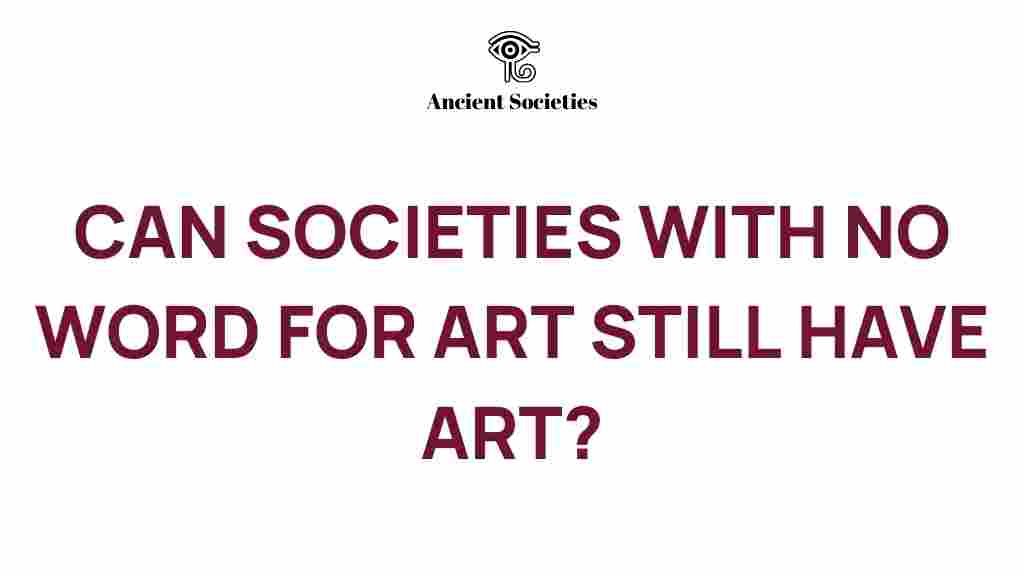Can Societies Without the Word “Art” Truly Appreciate Beauty?
The debate surrounding the concept of art and its relationship to beauty is as old as humanity itself. One intriguing aspect of this discussion is whether societies that lack a specific term for “art” can genuinely appreciate beauty. This question delves into the very essence of cultural expression, aesthetics, and the role of language in shaping our understanding of creativity and the human experience. In this article, we explore the intricate connections between language, culture, and the appreciation of beauty, providing insights from anthropology and psychology.
The Role of Language in Shaping Perception
Language is a powerful tool that shapes our thoughts, perceptions, and interactions with the world around us. The Sapir-Whorf Hypothesis suggests that the structure of a language affects its speakers’ worldview and cognition. In societies without a word for “art,” one might wonder how beauty is perceived and appreciated.
- Language as a Cultural Lens: Language provides a framework through which we interpret and express our experiences. Without a term for art, individuals might still engage in creative activities but may categorize them differently.
- Substitutes for Artistic Expression: Instead of “art,” cultures may use terms that encompass various forms of creative expression, such as “craft,” “ritual,” or “tradition.” These terms can reflect similar values and aesthetics.
Examples from Anthropology
Anthropological studies have shown that many cultures thrive without a direct equivalent of the word “art.” For instance:
- The !Kung San of Southern Africa: This indigenous group engages in storytelling, music, and dance as integral parts of their cultural expression, without categorizing these activities as “art.”
- The Inuit of the Arctic: Inuit sculptures and carvings are deeply tied to their cultural narratives and survival, reflecting beauty in functionality rather than in a separate category of “art.”
Through these examples, we can see that the absence of the word “art” does not hinder the appreciation of beauty; rather, it may redefine how beauty is conceptualized and expressed.
Understanding Aesthetics Beyond Language
Aesthetics—the study of beauty and taste—is not confined to those who have a word for “art.” It is a universal human trait. Even without explicit terminology, societies can experience and express beauty through various means:
- Natural Aesthetics: Many cultures find beauty in nature, such as landscapes, flora, and fauna, which can be appreciated through cultural narratives and practices.
- Functional Aesthetics: Objects created for utilitarian purposes can possess beauty, highlighting the marriage of form and function. For example, traditional pottery or textiles often embody aesthetic qualities while serving practical needs.
The Interplay of Creativity and Society
Creativity is a fundamental aspect of the human experience, deeply rooted in societal interactions. Even in the absence of a specific term for “art,” creativity flourishes:
- Community Engagement: Many creative expressions arise from communal activities, reinforcing bonds within a society. This collective creativity can lead to a shared appreciation of beauty.
- Rituals and Traditions: Cultural rituals often incorporate creative elements, showcasing beauty through performance, music, and storytelling. These practices highlight the aesthetic dimensions of human life.
As societies evolve, so too does their understanding and appreciation of beauty. The lack of a word for “art” does not equate to a lack of creativity; rather, it emphasizes the diverse ways in which beauty can manifest in a cultural context.
Step-by-Step Process: Understanding Beauty in Different Cultures
To grasp how societies without the word “art” appreciate beauty, we can analyze their approaches through a systematic lens:
- Identify Cultural Practices: Observe how cultures express creativity, whether through music, dance, storytelling, or craftsmanship.
- Analyze Aesthetic Values: Explore the values and beliefs that inform their definitions of beauty, which may differ from Western ideals.
- Explore Symbolism: Investigate the symbols and meanings attached to various creative expressions, which often reveal deeper societal values.
- Engage with Local Perspectives: Listen to the narratives and experiences of individuals within the culture to gain insights into their appreciation of beauty.
Troubleshooting Tips: Bridging Cultural Gaps
When attempting to understand and appreciate beauty in cultures without the word “art,” consider the following tips:
- Avoid Assumptions: Do not impose Western definitions of art and beauty on other cultures. Be open to alternative interpretations.
- Seek Context: Understand the cultural context behind creative expressions. What may seem mundane might hold significant aesthetic value within the culture.
- Engage Respectfully: Approach cultural expressions with respect and curiosity, fostering a genuine appreciation for diverse forms of creativity.
Conclusion: Beauty Beyond Language
In conclusion, societies without the word “art” can indeed appreciate beauty in profound ways. The absence of a specific term does not limit creativity or the capacity to experience aesthetics. Instead, it highlights the rich tapestry of cultural expression that exists worldwide. By examining how different societies engage with beauty—through rituals, community practices, and everyday life—we gain deeper insights into the universal human experience. Each culture, regardless of its linguistic constructs, has its unique lens through which beauty is perceived and celebrated.
Ultimately, our understanding of art, beauty, and creativity is enriched by recognizing the myriad ways in which they exist across diverse cultures. For further exploration of this topic, consider visiting this resource to deepen your understanding of cultural expressions and their significance.
As we continue to engage with different cultures, let us embrace the beauty that exists beyond words, celebrating the creativity that defines the human spirit.
This article is in the category Culture and created by AncientSocieties Team
